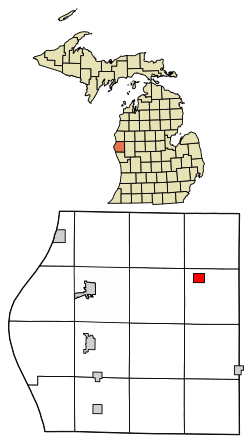Walkerville, Michigan facts for kids
Quick facts for kids
Walkerville, Michigan
|
|
|---|---|
|
Village
|
|
| Nickname(s):
The Ville
|
|

Location of Walkerville, Michigan
|
|
| Country | United States |
| State | Michigan |
| County | Oceana |
| Area | |
| • Total | 1.24 sq mi (3.22 km2) |
| • Land | 1.24 sq mi (3.22 km2) |
| • Water | 0.00 sq mi (0.00 km2) |
| Elevation | 889 ft (271 m) |
| Population
(2020)
|
|
| • Total | 246 |
| • Density | 197.75/sq mi (76.37/km2) |
| Time zone | UTC-5 (Eastern (EST)) |
| • Summer (DST) | UTC-4 (EDT) |
| ZIP code |
49459
|
| Area code(s) | 231 |
| FIPS code | 26-83020 |
| GNIS feature ID | 1622051 |
Walkerville is a small village located in Oceana County, Michigan, in the United States. It is a quiet community. In 2020, about 246 people lived there. The village is found within Leavitt Township.
Contents
The Story of Walkerville
Walkerville was started by the Walker family. This happened a long time ago in the 1800s. Once, a very busy railway went through the village. This helped the town grow.
Fires and Farming in Walkerville
Walkerville faced big challenges. The village had two major fires. These fires caused a lot of damage. The buildings and roads were badly hurt. The village has been working to rebuild since then.
Today, Walkerville is known for farming. It helps grow many fruits and vegetables. These include tasty cherries, crisp apples, and fresh asparagus. West Michigan is famous for these crops.
A Summer Camp Arrives
In the summer of 2020, something new happened. A camp called Camp Gan Israel came to Walkerville. This camp is usually based in Kalkaska Township, Michigan. They opened a new campground here.
This was the first time a Jewish group had a big presence in the village. About 100 staff and campers stayed there. This meant the camp's residents made up more than a third of Walkerville's population that summer.
Special Book Printing Event
During that summer, the camp did something special. They celebrated the 70th anniversary of the Rebbe's leadership. They printed 100 copies of a book called the Tanya. This book is an old work of Hasidic philosophy. It was first published in 1797.
The printing happened right in Walkerville. This was part of a plan by the Lubavitcher Rebbe. He wanted a Tanya printed in every city.
Walkerville's Location and Size
Walkerville is a small place. The United States Census Bureau measures its area. The village covers about 1.21 square miles (3.13 square kilometers). Most of this area is land. Only a small part is water.
Who Lives in Walkerville?
We can learn about the people of Walkerville from census information. A census counts how many people live in a place.
| Historical population | |||
|---|---|---|---|
| Census | Pop. | %± | |
| 1910 | 371 | — | |
| 1920 | 252 | −32.1% | |
| 1930 | 250 | −0.8% | |
| 1940 | 250 | 0.0% | |
| 1950 | 233 | −6.8% | |
| 1960 | 261 | 12.0% | |
| 1970 | 319 | 22.2% | |
| 1980 | 296 | −7.2% | |
| 1990 | 262 | −11.5% | |
| 2000 | 254 | −3.1% | |
| 2010 | 247 | −2.8% | |
| 2020 | 246 | −0.4% | |
| U.S. Decennial Census | |||
People in 2010
In 2010, there were 247 people living in Walkerville. They lived in 84 homes. About 63 of these were families. The village had about 228 people per square mile.
Most people in the village were White (83.4%). Some were African American (1.2%). Others were Native American (2.0%) or Asian (0.4%). About 17.8% of the people were Hispanic or Latino.
Many homes had children under 18. About 36.9% of homes had kids. Most homes (57.1%) were married couples. The average home had almost 3 people.
The average age in Walkerville was about 34 years old. About 27.5% of residents were under 18. About half the population was male (49.8%) and half was female (50.2%).
See also
 In Spanish: Walkerville (Míchigan) para niños
In Spanish: Walkerville (Míchigan) para niños

